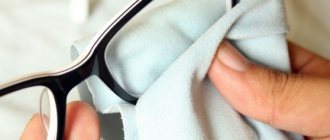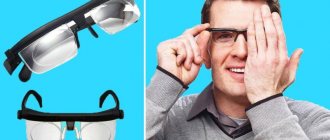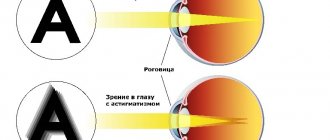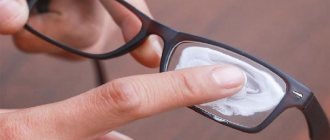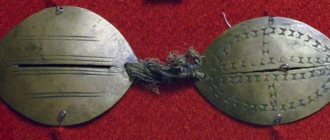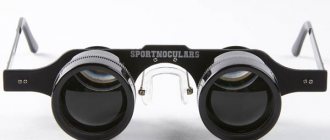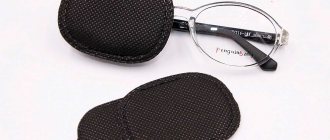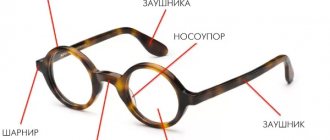Glasses: history of appearance and selection rules
Glasses: history of appearance and rules of choice
Eyeglasses that correct vision are an indispensable accessory not only for health, but also for human beauty due to the variety of frame shapes. How to choose them correctly?
glasses, vision, astigmatism, myopia, disease prevention
The eyes are aptly and insightfully called the mirror of the soul. Even if these eyes are not very accurate and not very keen. It’s just that in this case, the “mirror” needs a special “frame”, or rather, a frame. It’s not for nothing that the words “eyes” and “glasses” are so similar. And in our time, the latter can be not only a complement, but also a decoration of the former. The distant ancestors of today’s “bespectacled people” could only dream of this: regardless of the quality of their vision, they were forced to look at the world with the naked eye.
Those who wear glasses have higher intelligence. The traditional attitude towards people who wear glasses as being more intelligent has unexpectedly found its confirmation.
American ophthalmologists examined 1,500 people aged 15–60 years suffering from myopia and farsightedness. Studies have shown that 80% of people with glasses have a higher IQ than their peers with normal vision.
How glasses appeared: “optical stones”
Cicero (106–43 BC) complained about his eyes, and antiquity, despite all the successes of theoretical optics, was never able to help him. The only device that was described by Claudius Ptolemy (circa 90–160) but which was never used in everyday life was a glass ball filled with water. True, Pliny the Elder claims that “Emperor Nero watched the gladiatorial games through the emerald,” but this stone was a distant predecessor of sunglasses rather than optical glasses.
In the first half of the 11th century, the Arab scientist Ibn al-Haytham gave a description of the magnifying lens, which was translated into Latin in the mid-12th century. The Europeans immediately began experimenting. The English scientist and thinker Roger Bacon was the first to try to make eye lenses in 1267. He used rock crystal and beryl (die Brille – glasses) as materials. Despite the failure, information about the great discovery instantly spread throughout the Christian world: the increasing power of the “crystal stones” became a literary metaphor. For example, on the portal of a church in Spain, Saint Jerome, who lived 7 centuries before the invention, is depicted with such optical stones!
Sunglasses and corrective glasses - which ones appeared in Europe first?
It is believed that glasses for vision correction were invented first, but archaeological finds indicate otherwise. During excavations, scientists discovered unusual devices that looked very much like modern sunglasses. For the first time, archaeologists found such a product in the tomb of Tutankhamun, the pharaoh of Ancient Egypt. It was made from two thin cuts of emerald, connected to each other by a bronze plate. Scientists have discovered similar inventions in the burial places of other important people.
Some "precursors of glasses" were made from dark brown morion quartz. Today these finds are kept in the British Museum.
Emerald was used to create the first models of glasses in Ancient Rome. In those days, the precious stone was a kind of amulet. It was believed that wearing it helps improve vision. Ancient Roman healers advised rulers to look at emerald more often, as its color reduces eye fatigue. Emerald glasses were used by Emperor Nero, who suffered from myopia. He wore them to gladiator fights. Two lenses, made of polished emerald, were united by a frame and looked more like a lorgnette than glasses. It was impossible to put them on, since they did not have arms. This device could only be held in the hands.
How glasses appeared: “eye glasses”
The first real glasses appeared at the end of the 13th century in Northern Italy. They were believed to have been made by Salvino degli Armati, who is buried in the Cathedral of Santa Maria Maggiore in Florence. In 1300, the Great Council of the Republic of Venice adopted the first statute (charter, collection of rules) regulating the production of “reading stones”. And in 1305, Giordano de Rivalto from Pisa already mentions “eyeglasses for reading.”
The 14th century becomes the time of widespread adoption of glasses in the form of a monocle and lorgnette, and the earliest physically preserved specimen dates back to the middle of this century. It was found under the choir of the Windhausen monastery in Lower Saxony. At this time, the nose bridge was invented - this is evidenced by a fresco from 1352 from the monastery of San Nicolo in Trevisio. It depicts two cardinals: Nicholas of Rouen - with a monocle, Hugo of Provence - in pince-nez. At that time there were only glasses for farsighted people; glasses for myopia appeared only a century later. In the 15th century, wire bows were also invented. St. Anne is depicted wearing these glasses in a 1470 painting from the Amsterdam Museum, and these glasses look quite modern.
Frame shape: laws of optics and vagaries of fashion
The shape of glasses has changed several times and continues to change, and not always according to the laws of optics. This often happens due to the vagaries of fashion. In the 14th century, for example, they wore large, flashy glasses. Later, in the 18th century, a lorgnette, the frame of which had a handle, became an obligatory part of the ladies' toilet; The lorgnette was worn around the neck on a long chain. A monocle, a round glass for one eye, was inserted into the eye socket. In the 19th century, pince-nez came into fashion (and they were worn mainly by men). These are rimless glasses that are held on the nose using a spring that clamps the bridge of the nose. In the 20th century, glasses became the most common thing, and in the summer - even a mandatory fashion accessory.
Thanks to beautiful modern frames, glasses can look fashionable, interesting, and stylish. Therefore, those who are forced to wear glasses due to poor vision should not be upset: from an aesthetic point of view, glasses are not a disadvantage.
Metal spectacle frames
Some of the main requirements for metal eyeglass frames are resistance to corrosion (in other words, rust), light weight, and strength. Metal spectacle frames are usually made from a combination of different materials: one metal is used as a base metal (for the main structure of the spectacle frame itself), other metals or alloys can be used for coating. Plastics or other materials (wood, bone, etc.) can be used to make various parts of the spectacle frame and its finishing. For nose pads, cellulose acetate, silicones, or other polymers with similar properties are usually used. Please be aware that some metals may cause allergic reactions.
Titanium
Titanium is considered one of the best materials for eyeglass frames. It has a characteristic grayish-silver metallic tint, is very light and durable, and hypoallergenic. Eyeglass frames made from pure titanium are very beautiful (they are now available in a wide range of colors), and manufacturers use this metal to make prestigious models that are considered luxury. Cheaper eyeglass frames made of various alloys, in which the share of titanium is limited to 70-80%, are much more common on the optical market. The remaining additives are other metals: aluminum, chromium, iron, etc. Titanium eyeglass frames often contain nickel and cobalt.
Flexon
Flexon is a brand name for a titanium-nickel alloy developed by Marchon Eyewear for the production of fashionable eyeglass frames and sunglasses. Flexon is called a metal “with memory” because glasses frames made from it return to their original shape even after severe deformation. Flexon glasses are difficult to break and are therefore especially recommended for sports and children. In addition, spectacle frames made from Flexon are lightweight and hypoallergenic. Note that in addition to spectacle frames made from Flexon, the optical market also offers spectacle frames made from other alloys, which also belong to the group of “memory” metals.
Monel
Monel is an alloy based on nickel (up to 67%) and copper with small additions of other metals. Monel is widely used for making eyeglass frames due to its strength and corrosion resistance. Spectacle frames made from alloys containing nickel usually have coatings (varnish or inert metals) that protect the facial skin from direct contact with the metal. Therefore, quality monel eyeglass frames are actually hypoallergenic until the protective coating wears out.
Stainless steel
Stainless steel is an alloy of iron and chromium (10-30%). Spectacle frames made from it are durable, light weight, corrosion resistant, and relatively cheap. Many grades of stainless steel do not contain nickel and are therefore considered hypoallergenic.
Aluminum
Aluminum is used to make lightweight eyeglass frames that are very resistant to corrosion. Aluminum eyeglass frames belong to the “hi-tech” style, which makes this material very attractive to some eyeglass frame designers working in this fashion trend.
Other metals are also used in the production of eyeglass frames. They can be included in alloys as additives to improve the properties of the base metal, or they can be used to finish eyeglass frames made from other materials. Silver and gold are applied to the parts of the spectacle frames in the form of coatings. Usually, not pure gold or silver is used for this, but their alloys. The gold content in the alloy is determined in carats (1 carat corresponds to 1/24 of the alloy weight: 12 carats - 50% gold, 24 carats - 100% gold). Please also note that the gold color of a spectacle frame does not indicate that it contains gold.
Wood, bone and leather are also not forgotten by designers because of their natural appearance and beauty. Precious and semi-precious stones are also used to decorate expensive eyeglass frames.
Articles on the topic
- How to choose eyeglass frames
- What you need to know about eyeglass frame sizes
How to choose frames based on your face features
With the help of a well-chosen frame, even some errors in the structure of the face can be optically corrected. For example, if the nose is too long, glasses should be worn slightly below the bridge of the nose - this way the nose becomes optically shorter. And a wide nose becomes optically narrower if you wear glasses below the bridge of your nose. People with a small face and a small nose should not wear glasses with large, flashy frames, since then the face is “lost” and the smallness of the features becomes especially noticeable; In this case, it is recommended to wear glasses as high on the nose as possible. People with oval faces can wear glasses of any type and shape.
If you find it difficult to choose glasses yourself, consult a specialist. Here are some tips for adjusting your face shape with glasses.
Triangular face with a wide lower part The rectangular shape of the glasses optically widens the face, which is narrowed at the temples. The color of the frame should be in harmony with the color of your hair and face. Frames with golden and warm tones are recommended to soften the overall look.
Heart-shaped face Medium-sized glasses with oval frames are suitable for this type. Eyebrows should be visible above the frame. Skillfully tinted lips make the narrowness of the lower part of the face optically less noticeable.
Round face With this type of face, it is better to wear large, flashy glasses, which distract attention and at the same time make the face more noticeable. The frames of the glasses should be dark.
Wide face With this type of face, it is best to wear oval-shaped glasses. If the eyebrows are too thick and wide, then they should be plucked a little so that they do not optically overwhelm the thin frames of the glasses. The oval line of the frame should follow the oval of the face.
Eye makeup for those who wear glasses
Eye makeup should be in harmony with the color of the frame and the shape of the glasses. The colors of the “cold” range are suitable for thin metal and blue frames: lilac, smoky gray, silver blue, mother-of-pearl. However, lipstick and makeup in this case should be more intense. For thin transparent frames or golden-colored frames, select brown or beige shadows and a contour pencil of the same shades.
With myopia, glasses make your eyes appear smaller, so it is necessary that makeup make them appear larger. For a similar effect, shadows of light colors are applied to the upper eyelid, darker ones are applied under the eyebrows, and the outer corner of the eye is emphasized with a brown pencil. Some cosmetologists advise applying a little blush around the eyes, starting from the place where the frame meets the cheekbone and gradually moving up to the eyebrows.
With farsightedness, the lenses of the glasses visually enlarge the eyes, giving the impression that they are closer to the nose, so makeup should slightly increase the distance between them. To do this, the inner corner of the eye is emphasized with very light shadows. The makeup is light; it is better to tint the eyelashes with mascara only partially, closer to the outer edge of the eye.
When selecting the shape of safety glasses, you should be guided by the same rules as when selecting glasses with diopters.
Contact lenses: who, when, why
For representatives of some professions (actors, athletes, people working in damp environments), glasses are a serious hindrance. Currently, this problem is easily solved with the help of gel contact lenses. They can be worn by almost all nearsighted and farsighted people, provided that their visual error is more than two diopters. Contact lenses provide normal vision in both eyes, even if each eye has different dioptric measurements, and the difference between them is large. In addition, contact lenses can even replace the lens of the eye damaged as a result of illness or injury; Thanks to contact lenses, the patient sees with both eyes, despite significant damage to the lens.
Along with soft gel contact lenses, hard gel contact lenses are also produced, prescribed by doctors in cases where the use of soft contact lenses is contraindicated (for visual impairments such as astigmatism, etc.). Hard contact lenses have the same comprehensive applications as soft ones.
Some people wear contact lenses for several hours a day, but most wear them throughout the day. Colored contact lenses are now available to make your eyes more expressive.
A new round of development: the popularity of sunglasses
Everything changed in the first half of the 20th century, when industry began to develop at a rapid pace. The demand for sunglasses has skyrocketed, and optics have helped with this... cars.
The first cars did not have a roof, so the hats favored by the bourgeoisie and aristocracy turned out to be ineffective - they were instantly torn off the head as soon as the foot touched the gas pedal. The glasses turned out to be very useful: they protected the eyes from blinding rays, oncoming gusts of wind and road dust flying into the face.
In the 20s, the fashion for sunglasses finally took hold: it was at this time that one of the main style icons, Mademoiselle Chanel, set the tanning trend. At the same time, outdoor sports such as golf and tennis became especially popular. Both went well with sunglasses. Moreover, soon sunglasses became a real symbol of success, youth, popularity. Now everyone dreams of having such an accessory.
The first variation of sunglasses, different from the classic models, were aviators.
. With teardrop-shaped lenses and a thin metal frame, the model was originally designed for military and civilian pilots. But ordinary people, those who were outside aviation, did not have the opportunity to get such points.
Ray-Ban specialists foresaw the commercial success of aviators and within a few years launched the production of glasses that anyone could now afford. But real fame came to the “aviators” only in the late 60s, after the release of the film “Easy Rider”. To this day, this model is considered iconic.
Subsequently under the Ray-Ban
Several more models were released that are still relevant today. Among them, for example, are the famous wayfarer and clubmaster - models with half a century of history.
Despite the popularity of sunglasses as an accessory, until the second half of the 1980s, the road to the world of high fashion remained closed to them. If a model appeared on the catwalk wearing glasses, it was only to highlight something from her clothing or complete the look. Often, fashion designers simply did not like the design of glasses, but they could not influence it, which is why the accessory was an infrequent guest on the catwalk.
Everything changed when couturiers took on the development of glasses personally. Almost every fashion house had its own line of glasses; fashion designers boldly experimented with shapes and designs and began to include glasses in almost all collections. The release of branded glasses allowed us to take the accessory to a new level.
How to help your eyes
- The workplace must be sufficiently illuminated, the light field should be evenly distributed over the entire area of the workspace, and light rays should not fall directly into the eyes. The distance from the eyes to the book or notebook should be 35–40 cm. It is better to install the book not in a horizontal position, but in an inclined position at an angle of 45 degrees.
- When watching TV shows, you should sit at a distance from the screen so that your eyes do not strain, but no closer than 2–2.5 m from the screen. Keep your head straight, without bending forward. Periodically, you need to close your eyelids for a few seconds to give your eye muscles a rest and relaxation.
- When working on a computer, take a 10-minute break every 40 minutes, during which it is advisable to look into the distance. The monitor field should be covered with a protective screen that is as far away from the eyes as possible (at least 50–60 cm). If you have difficulty seeing the image at this distance and cannot see the image clearly, then it is better to choose a larger font size for your work. When working on a computer, you need to wear special corrective glasses every 2-3 hours to relieve spasm of the eye muscles.
- Those whose myopia exceeds 2-4 units need to have 2 pairs of glasses: for working “near” and “for distance”. It is not recommended to read in transport, lying on your back or in a dimly lit room.
- If there is negative dynamics in the retina of the eye with stable and slight myopia, it is necessary to switch to a calmer lifestyle. Completely eliminate lifting weights of more than 5 kg, avoid sharp bends, jumping into water and loads associated with accelerating the pace.
- The diet of people with impaired vision should include foods that can effectively strengthen the retinal vessels and “nourish” the eyes: blueberries, black currants; The most useful vegetable is carrots. The diet of myopic people should always include cod liver and greens: parsley, dill, green onions. For retinal dystrophy, it is useful to drink rosehip infusion daily.
- Those suffering from myopia should take complexes that combine multivitamins with microelements, primarily calcium. All preparations based on blueberries are useful.
- Eye washes with black and green tea and warm lotions of chamomile decoction on closed eyes help relieve fatigue. You need to protect your eyes from ultraviolet exposure to sunlight.
Author: Elena Roshchina, ophthalmologist
The material uses photographs belonging to shutterstock.com
History of sunglasses
The most ancient sunglasses can be called devices found during excavations of sites in the North. Northern peoples used protective plates with slits for eyes made of bark or bone to protect themselves from the bright sun. In China, pieces of smoked quartz were used to protect from sunlight. Napoleon ordered a large batch of glasses (about 200 thousand pieces) for his expedition to Egypt in 1798. The bright African sun caused cataracts and other eye diseases in Europeans who were not accustomed to it. Today, when millions of people around the world use glasses, it is difficult to imagine a world without this great invention for vision correction and sun protection. Of course, it is difficult to establish for certain who exactly invented the first lenses, what exactly they were, all that remains is to gratefully accept the fruits of the labor of our ancestors.
